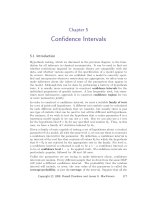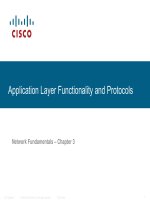Network Fundamentals–Chapter 5 ppsx
Bạn đang xem bản rút gọn của tài liệu. Xem và tải ngay bản đầy đủ của tài liệu tại đây (1.46 MB, 48 trang )
© 2006 Cisco Systems, Inc. All rights reserved. Cisco PublicITE I Chapter 6
1
OSI Network Layer
Network Fundamentals – Chapter 5
© 2006 Cisco Systems, Inc. All rights reserved. Cisco PublicITE 1 Chapter 6
2
Objectives
Learning Objectives
Upon completion of this chapter, you will
be able to:
– Identify the role of the Network layer as it
describes communication from one end
device to another end device.
– Examine the most common Network layer
protocol, Internet Protocol (IP), and its
features for providing connectionless and
best-effort service.
– Understand the principles used to guide
the division, or grouping, of devices into
networks.
– Understand the hierarchical addressing of
devices and how this allows
communication between networks.
– Understand the fundamentals of routes,
next-hop addresses, and packet
forwarding to a destination network.
© 2006 Cisco Systems, Inc. All rights reserved. Cisco PublicITE 1 Chapter 6
3
Network Layer – Communication from Host to Host
The Network layer, or OSI Layer 3, provides
services to exchange the individual pieces of
data over the network between identified end
devices.
–Unlike the Transport layer (OSI Layer 4), which
manages the data transport between the processes
running on each end host, Network layer protocols
specify the packet structure and processing used to carry
the data from one host to another host. Operating without
regard to the application data carried in each packet
allows the Network layer to carry packets for multiple
types of communications between multiple hosts.
To accomplish this end-to-end transport, Layer 3
uses 4 basic processes:
1. Addressing
2. Encapsulation
3. Routing
4. Decapsulation
© 2006 Cisco Systems, Inc. All rights reserved. Cisco PublicITE 1 Chapter 6
4
Network Layer – Communication from Host to Host
1. Addressing
–If individual pieces of data are to be directed to an
end device, that device must have a unique address.
–When an address is added to a device, the device is
referred to as a host.
2. Encapsulation
–Not only the devices be identified with an address, the
individual pieces - the Network layer PDUs - also
contain these addresses.
–When referring to the Network layer, we call this PDU
a packet.
–The address of the host to which it is being sent. This
address is referred to as the destination address.
–The address of the originating host is called the
source address.
© 2006 Cisco Systems, Inc. All rights reserved. Cisco PublicITE 1 Chapter 6
5
Network Layer – Communication from Host to Host
3. Routing
–During the routing through an internetwork, the
packet may traverse many intermediary devices.
•Each router that a packet takes to reach the next
device is called a hop.
•As the packet is forwarded, its contents (Transport
layer PDU), remain intact until the destination host is
reached.
–If the source and destination hosts are not connected to
the same network.
•The Network layer must provide services to direct
these packets to their destination host.
•Intermediary devices that connect the networks are
called routers.
•The role of the router is to select paths for and direct
packets toward their destination.
4. Decapsulation
–Finally, the packet arrives at the destination host
and is processed at Layer 3.
–The packet is decapsulated by the Network layer
and passed up to the appropriate service at
Transport layer.
© 2006 Cisco Systems, Inc. All rights reserved. Cisco PublicITE 1 Chapter 6
6
Network Layer Protocols
Protocols implemented at the Network layer that
carry user data include:
–Internet Protocol version 4 (IPv4)
–Internet Protocol version 6 (IPv6)
–Novell Internetwork Packet Exchange (IPX)
–AppleTalk
–Connectionless Network Service (CLNS/DECNet)
The Internet Protocol (IPv4 and IPv6) is the most
widely-used Layer 3 data carrying protocol and
will be the focus of this course.
© 2006 Cisco Systems, Inc. All rights reserved. Cisco PublicITE 1 Chapter 6
7
IP V4 Protocol
The Network layer services implemented by the
TCP/IP protocol suite are the Internet Protocol
(IP).
–Version 4 of IP (IPv4) is currently the most widely-
used version of IP.
•It is the only Layer 3 protocol that is used to carry user
data over the Internet and is the focus of the CCNA.
–IP version 6 (IPv6) is developed and being
implemented in some areas.
•IPv6 will operate alongside IPv4 and may replace it in
the future.
IPv4 basic characteristics:
–Connectionless - No connection is established
before sending data packets.
–Best Effort (unreliable) - No overhead is used to
guarantee packet delivery.
–Media Independent - Operates independently of
the medium carrying the data.
© 2006 Cisco Systems, Inc. All rights reserved. Cisco PublicITE 1 Chapter 6
8
IP V4 Protocol - Connectionless Service
An example of connectionless communication is
sending a letter to someone without notifying the
recipient in advance.
Connectionless data communications works on the
same principle.
–IP packets are sent without notifying the end host that
they are coming.
Connection-oriented protocols, such as TCP,
–require that control data be exchanged to establish the
connection as well as additional fields in the PDU header.
–IP is connectionless, it requires no initial exchange of
control information to establish an end-to-end connection,
nor does it require additional fields in the PDU header to
maintain this connection.
Connectionless packet delivery may, however, result in
packets arriving at the destination out of sequence.
–If out-of-order or missing packets create problems for the
application using the data, then upper layer services will
have to resolve these issues.
© 2006 Cisco Systems, Inc. All rights reserved. Cisco PublicITE 1 Chapter 6
9
IP V4 Protocol - Best Effort Service (unreliable)
Since protocols at other layers can manage
reliability, IP is allowed to function very efficiently
at the Network layer.
–As with all layer isolation provided by network
models, leaving the reliability decision to the
Transport layer makes IP more adaptable and
accommodating for different types of
communication.
IP is often referred to as an unreliable protocol.
–The header of an IP packet does not include
fields required for reliable data delivery.
•There are no acknowledgments of packet delivery.
•There is no error control for data.
•Nor is there any form of packet tracking.
–Unreliable in this context does not mean that IP
works properly sometimes and does not function
well at other times.
–Unreliable means simply that IP does not have
the capability to manage, and recover from,
undelivered or corrupt packets.
© 2006 Cisco Systems, Inc. All rights reserved. Cisco PublicITE 1 Chapter 6
10
IP V4 Protocol - Media Independent
The Network layer is also not burdened with the media on
which packets will be transported.
–IPv4 and IPv6 operate independently of the media that carry
the data at lower layers of the protocol stack.
–Any individual IP packet can be communicated electrically
over cable, optical signals over fiber, or wirelessly as radio
signals.
–It is the responsibility of the OSI Data Link layer to take an
IP packet and prepare it for transmission over the
communications medium.
There is, however, one major characteristic of the media
that the Network layer considers:
–It is referred to as Maximum Transmission Unit (MTU).
–The maximum size of PDU that each medium can transport.
–The Data Link layer passes the MTU to the Network layer.
–The Network layer then determines how large to create the
packets.
In some cases, an intermediary device - usually a router -
will need to split up a packet when forwarding it from one
media to a media with a smaller MTU.
–This process is called fragmenting the packet or
fragmentation.
© 2006 Cisco Systems, Inc. All rights reserved. Cisco PublicITE 1 Chapter 6
11
IP V4 Packet
IPv4 encapsulates, the Transport layer segment or
datagram so that the network can deliver it to the
destination host.
–The process of encapsulating data by layer enables the
services at the different layers to develop and scale
without affecting other layers.
–This means that transport layer segments can be
readily packaged by existing Network layer protocols,
such as IPv4 and IPv6 or by any new protocol that might
be developed in the future.
–In all cases, the data portion of the packet - that is, the
encapsulated Transport layer PDU - remains unchanged
during the Network layer processes.
Routers can implement these different Network layer
protocols to operate concurrently over a network to
and from the same or different hosts.
–The routing performed by these intermediary devices
only considers the contents of the packet header that
encapsulates the segment.
© 2006 Cisco Systems, Inc. All rights reserved. Cisco PublicITE 1 Chapter 6
12
IP V4 Packet Header
As shown in the figure, an IPv4 protocol defines many
different fields in the packet header.
This course will consider these 6 key fields:
–IP Source Address
–IP Destination Address
–Time-to-Live (TTL)
–Type-of-Service (ToS)
–Protocol
–Fragment Offset
IP Source Address (32 bits)
–represents the source Network layer host address.
IP Destination Address (32 bits)
–represents the destination Network layer host address.
© 2006 Cisco Systems, Inc. All rights reserved. Cisco PublicITE 1 Chapter 6
13
IP V4 Packet Header
Time-to-Live (8 bits)
–The Time-to-Live (TTL) indicates the remaining "life" of
the packet.
–The TTL value is decreased by at least one each time
the packet is processed by a router (that is, each hop).
–When the value becomes zero, the router discards or
drops the packet and it is removed from the network data
flow.
–This mechanism prevents packets that cannot reach
their destination from being forwarded indefinitely
between routers in a routing loop.
–Decrementing the TTL value at each hop ensures that it
eventually becomes zero and that the packet with the
expired TTL field will be dropped.
© 2006 Cisco Systems, Inc. All rights reserved. Cisco PublicITE 1 Chapter 6
14
IP V4 Packet Header
Time-to-Live: Demo
© 2006 Cisco Systems, Inc. All rights reserved. Cisco PublicITE 1 Chapter 6
15
IP V4 Packet Header
Protocol (8 bits)
–This filed indicates the data payload type that the packet is
carrying. The Protocol field enables the Network layer to pass the
data to the appropriate upper-layer protocol.
–Example values are:
01 ICMP; 06 TCP; 17 UDP
Type-of-Service (8 bits)
–The field is used to determine the priority of each packet.
–This value enables a Quality-of-Service (QoS) mechanism to be
applied to high priority packets, such as those carrying telephony
voice data.
Fragment Offset (13 bits)
–The fragment offset field identifies the order in which to place the
packet fragment in the reconstruction.
More Fragments flag (1 bit)
–The More Fragments flag bit is set (MF = 1), it means that it is not
the last fragment of a packet.
–When a receiving host receives a frame with the MF = 0 and a
non-zero value in the Fragment offset, it places that fragment as
the last part of the reconstructed packet.
–An unfragmented packet has all zero fragmentation information
(MF = 0, fragment offset =0).
Don't Fragment flag (1 bit)
–If the Don't Fragment flag bit is set (DF = 1), then fragmentation
of this packet is NOT permitted.
© 2006 Cisco Systems, Inc. All rights reserved. Cisco PublicITE 1 Chapter 6
16
IP V4 Packet Header
Don't Fragment flag (1 bit)
–If the Don't Fragment flag bit is set (DF = 1), then fragmentation
of this packet is NOT permitted.
© 2006 Cisco Systems, Inc. All rights reserved. Cisco PublicITE 1 Chapter 6
17
IP V4 Packet Header: Other IPv4 Header Fields
Version (4 bits)
–Contains the IP version number (4).
Header Length (IHL) (4 bits)
–Specifies the size of the packet header.
Packet Length (16 bits)
–This field gives the entire packet size, including header and
data, in bytes.
Identification (16 bits)
–This field is primarily used for uniquely identifying fragments of
an original IP packet.
Header Checksum (16 bits)
–The checksum field is used for error checking the packet
header.
Options (variable length)
–There is provision for additional fields in the IPv4 header to
provide other services but these are rarely used.
© 2006 Cisco Systems, Inc. All rights reserved. Cisco PublicITE 1 Chapter 6
18
IP V4 Packet Header: Typical IP Packet
Ver = 4;
–IP version.
IHL = 5;
–size of header in 32 bit words (4 bytes).
–This header is 5*4 = 20 bytes, the minimum valid size.
Total Length = 472;
–size of packet (header and data) is 472 bytes.
Identification = 111;
–original packet identifier (required if it is later fragmented).
Flag = 0;
–denotes packet can be fragmented if required.
Fragment Offset = 0;
–denotes that this packet is not currently fragmented.
Time to Live = 123;
–denotes the Layer 3 processing time in seconds before the packet
is dropped (decremented by at least 1 every time a device
processes the packet header).
Protocol = 6;
–denotes that the data carried by this packet is a TCP segment .
© 2006 Cisco Systems, Inc. All rights reserved. Cisco PublicITE 1 Chapter 6
19
Networks – Separating Hosts into Common Groups
As the number of hosts on the network
grows, more planning is required to manage
and address the network.
–Rather than having all hosts everywhere
connected to one vast global network, it is
more practical and manageable to group hosts
into smaller networks.
–These smaller networks are often called
subnetworks or subnets.
As shown in the figure, networks can be
grouped based on factors that include:
–Geographic location
–Purpose
–Ownership
© 2006 Cisco Systems, Inc. All rights reserved. Cisco PublicITE 1 Chapter 6
20
Networks – Separating Hosts into Common Groups
Grouping Hosts Geographically
–Grouping hosts at the same location - such as each
building on a campus or each floor of a multi-level
building - into separate networks can improve network
management and operation.
Grouping Hosts for Specific Purposes
–Users who have similar tasks typically use common
software, common tools, and have common traffic
patterns.
–We can often reduce the traffic by placing the resources
to support them in the network with the users.
•For example, graphic designers who use the network to
share very large multimedia files.
Grouping Hosts for Ownership
–Using an organizational (company, department) basis
for creating networks assists in controlling access to the
devices and data as well as the administration of the
networks.
© 2006 Cisco Systems, Inc. All rights reserved. Cisco PublicITE 1 Chapter 6
21
Why Separate Hosts into Networks?
Common issues with large networks are:
–Performance degradation
–Security issues
–Address Management
© 2006 Cisco Systems, Inc. All rights reserved. Cisco PublicITE 1 Chapter 6
22
Why Separate Hosts into Networks? - Performance
Large numbers of hosts connected to a single network can
produce volumes of data traffic that may stretch, if not
overwhelm, network resources such as bandwidth and
routing capability.
–Dividing large networks so that hosts who need to communicate
are grouped together reduces the traffic across the internetworks.
In addition to the actual data communications between hosts,
network management and control traffic (overhead) also
increases with the number of hosts. A significant contributor
to this overhead is network broadcasts.
–A broadcast is a message sent from one host to all other hosts
on the network.
–And because every other host has to process the broadcast
packet it receives, the other productive functions that a host is
performing are also interrupted or degraded.
–However, large numbers of hosts generate large numbers of
broadcasts that consume network bandwidth.
–Broadcasts are a necessary and useful tool used by protocols to
enable data communication on networks.
–Broadcasts are contained within a network.
–In this context, a network is also known as a broadcast domain.
© 2006 Cisco Systems, Inc. All rights reserved. Cisco PublicITE 1 Chapter 6
23
Why Separate Hosts into Networks? - Security
The IP-based network that has become the Internet.
–As individuals, businesses, and organizations have
developed their own IP networks that link to the Internet.
–Dividing networks based on ownership means that
access to and from resources outside each network can
be prohibited, allowed, or monitored.
For example, a college network can be divided into
administrative, research, and student subnetworks.
–Dividing a network based on user access is a means to
secure communications and data from unauthorized
access by users both within the organization and outside
it.
–Security between networks is implemented in an
intermediary device (a router or firewall appliance) at the
perimeter of the network.
–The firewall function performed by this device permits
only known, trusted data to access the network.
© 2006 Cisco Systems, Inc. All rights reserved. Cisco PublicITE 1 Chapter 6
24
Why Separate Hosts into Networks? – Address Management
The Internet consists of millions of hosts, each of
which is identified by its unique Network layer
address.
–To expect each host to know the address of
every other host would impose a processing
burden on these network devices that would
severely degrade their performance.
Dividing large networks so that hosts who need
to communicate are grouped together reduces
the unnecessary overhead of all hosts needing
to know all addresses.
–For all other destinations, the hosts only need to
know the address of an intermediary device, to
which they send packets for all other destinations
addresses.
–This intermediary device is called a gateway.
•The gateway is a router on a network that serves as
an exit from that network.
© 2006 Cisco Systems, Inc. All rights reserved. Cisco PublicITE 1 Chapter 6
25
Why Separate Hosts into Networks? – Hierarchical Addressing
To support data communications between
networks over internetworks, Network layer
addressing schemes are hierarchical.
Using hierarchical addressing means that the
layer 3 address are divided into a network level
and then the host level.
–Layer 3 addresses supply the network portion of
the address. Routers forward packets between
networks by referring only to the part of the
Network layer address that is required to direct the
packet toward the destination network.
–By the time the packet arrives at the destination
host network, the whole destination address of the
host will have been used to deliver the packet.
–If a large network needs to be divided into smaller
networks, additional layers of addressing can be
created.
postal addresses are prime
examples of hierarchical
addresses.









